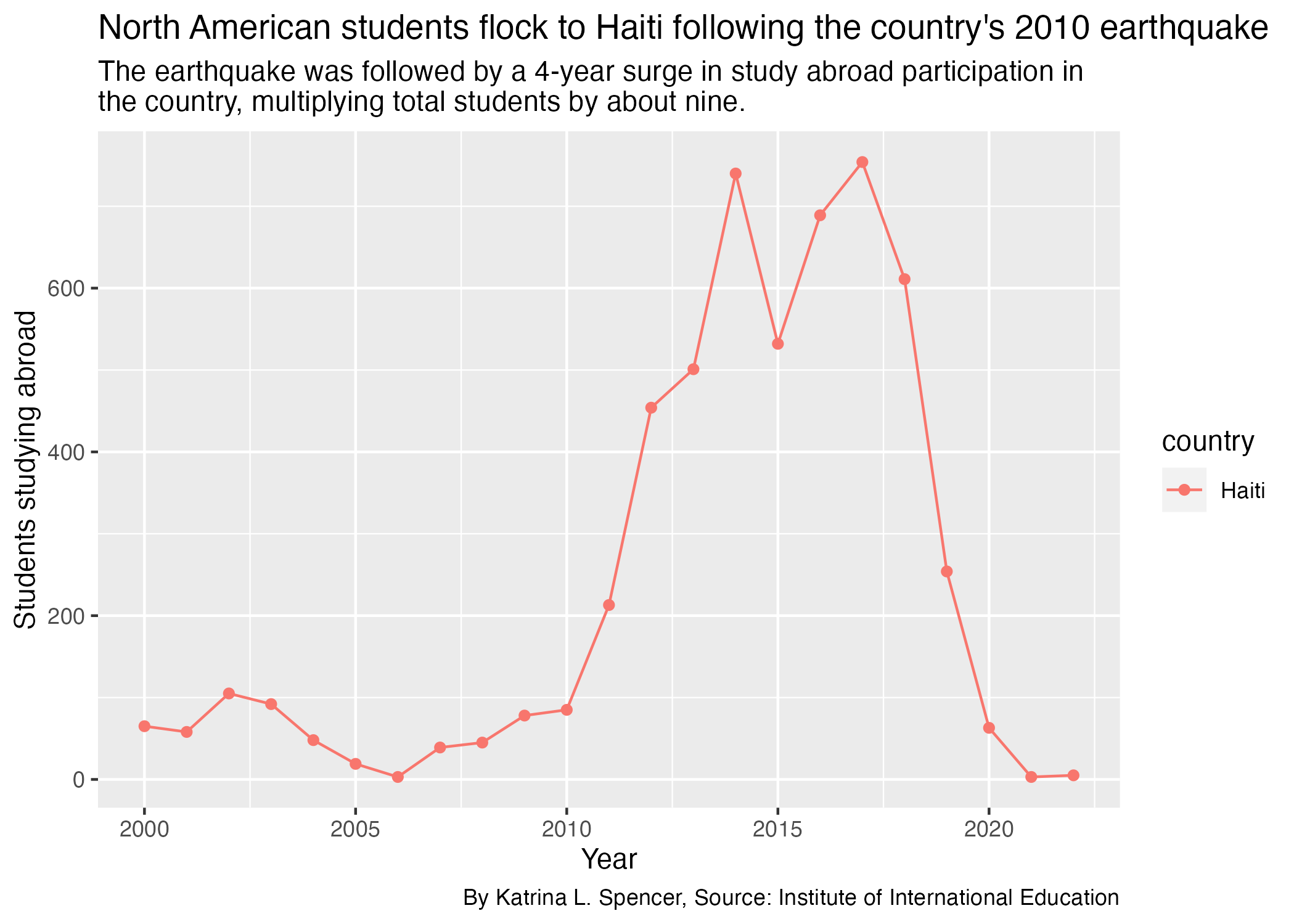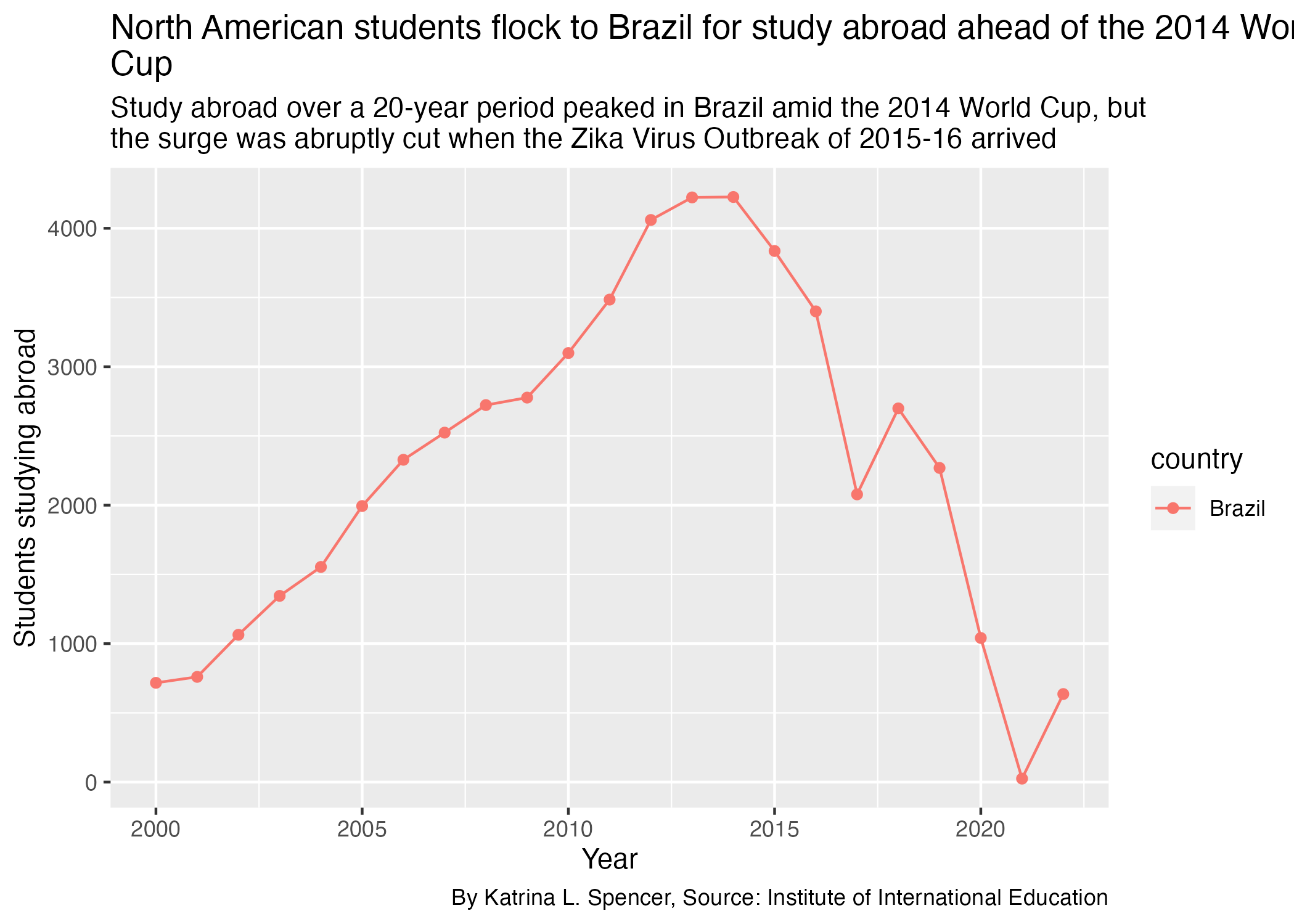Study Abroad
Link to data: https://opendoorsdata.org/data/us-study-abroad/all-destinations/
The data imported for this project comes from the Institute of International Education (IIE) as seen on https://opendoorsdata.org. It is a collection of counts of students from the United States studying abroad in foreign countries for credit from the academic years 1999 to 2022. The information includes broad global regions like Africa or Europe and countries like South Africa or Spain.
Questions of interest include what global region and/or country is most frequently visited by students from the United States in study abroad programs and which are least visited by the same group. However, remarkable events like major sporting events, terrorist attacks, natural disasters and endemic viruses may help to predict increases or decreases in study abroad participation at certain sites as well.
Where North American students choose to study abroad can be impacted by global events of diverse types, and sometimes in unexpected ways, according to data provided by the Institute of International Education (IIE). While the COVID-19 global pandemic marked a precipitous and obvious decline in study abroad overall for this group over the past 20 years, viruses and travel bans are not the only events that reveal drops and jumps in study abroad participation. The death of a leader, for example, Cuba’s long-term president Fidel Castro, coincided with remarkable growth in study abroad participation in and on the island country. The 2010 earthquake in Haiti also coincided with North American students’ increased interest in the country. Other events that coincide with North American students’ increased interest include foreign countries’ hosting of major sporting events and/or a host country’s intentional investment in tourism. Decreases in participation in study abroad coincided with a terrorist attack, a drug war and a natural disaster. Moreover, North American students seem to most prefer English-speaking nations when it comes to their study abroad experiences in both Europe and Africa.
The data provided by the IIE has been manipulated in one significant way to facilitate charting. Academic years that typically rely on a fall semester and a spring semester, covering a 9-month period, have been represented in charted visualizations as standard calendar years. For example, the Fall 1999-Spring 2000 academic year has been represented in visualizations as “2000.” This naming pattern should be assumed and understood for all following years charted as well.
Data takeaways:
- Europe is the most visited world region by far by North American students for study abroad.
- East Asia is the second most visited world region by North American study abroad students.
- About 4,000 North Americans studied abroad in the Middle East in 2000. That number was reduced to a third of that figure in 2001, which coincides with the September 11th attacks. The number of students continued to reduce, meeting its lowest amount for the period of 1999-2022, in 2003. Even fewer students studied abroad in the Middle East in 2003 than during the 2021 period of the global COVID-19 pandemic in 2021. In 2019, nearly 6,000 North American students studied abroad in the Middle East, the highest number for the 1999- 2022 period.
- The three countries in the Middle East most often visited by North American study abroad students between 1999 and 2022 were Israel, Jordan and the United Arab Emirates.
- The dramatic decline in students from the United States visiting Mexico for study abroad coincides with the Mexican drug war. Between 2009 and 2014, Mexico lost 70% of its study abroad students. This period also coincided with a dramatic rise in study abroad to Costa Rica. In the same time period, study abroad to Costa Rica reached its highest point, moving from just over 6,000 participants in 2009 to over 8,000 in 2015.
- Of the East Asian countries, North American students visit China, Japan and South Korea most for study abroad.

- Haiti saw a dramatic increase of North American students studying abroad there following its 2010 earthquake. By 2014, about nine times as many students visited Haiti as in 2000.

- Study abroad participation for North American students to Brazil peaked in 2013 and 2014 over the 2000- 2020 time span. This peak coincides with the World Cup being hosted in Brazil. Shortly thereafter, however, there were sharp declines, which coincided with both the end of the World Cup and the Zika virus outbreak in 2015- 2016. While there were just over 4,000 North American students in 2013 and 2014 in Brazil, the number dropped to about half that sum in 2016.
- There was a sharp and sudden decline in North American students studying abroad in Japan in 2011, which coincided with the country’s tsunami that year. Programs lost more than 1,000 participants, which made up about one-sixth of its total in 2010. In 2019, however, right before Japan hosted the Olympic games, the total number of students present was about three times as high than it was in the year 2000. North American study abroad participants in Japan peaked at over 8,000 in number in 2019, preceding a sharp decline to 0 in 2021, coinciding with the COVID-19 global pandemic.
- Following Cuban president Fidel Castro’s death in 2016, study abroad for North American students to the island country jumped from about 2,500 in 2015 to over 4,000 in 2017.
- The Philippines’ Department of Tourism designated 2015 as the “Visit the Philippines Year.” Based on two years preceding this declaration and two years following, the campaign appeared to be successful. About 275 North American students studied abroad in the Philippines in 2013. More than 500 studied there in 2017.
- While Nigeria is the most populous country on the African continent, it receives the least amount of North American study abroad students between several English-speaking countries including Ghana, Kenya, Liberia and South Africa. South Africa, on the other hand, has seen a rather steady increase in interest from the same group over a 17-year period. Participants have grown six times in number from around 1,000 in the year 2000 and to 6,000 in 2017.